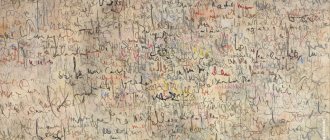Rhetoric
The formation of Russian rhetoric
In the Middle Ages, European rhetorical ideas penetrated into Russia through Poland and Ukraine. The development of Russian rhetoric has acquired special significance in the history of the normalization of the Russian literary language, in the formation of real social and communicative forms of communication between Russians.
In Rus', eloquence was called broadcasting, which developed mainly at public meetings - veche.
In addition to broadcasting, such types of eloquence as solemn (or praiseworthy), military and diplomatic speeches also developed.
The basis of Old Russian eloquence was folk traditions, and with the adoption of Christianity in 988, Byzantine and South Slavic models. Some texts have reached us that testify to the high culture of oral speech. Ancient Russian eloquence was characterized by such traditions as high respect for verbal skill, morally instructive pathos, the belief that the gift of speech is a great virtue, a gift from God; meekness, humility in public speech and conversation, high emotional intensity of appeals and appeals, complete absence of servility and flattery.
The first Russian manuals on rhetoric were written by Bishop Macarius (1617–1619), M.I. Usachev (1699), Feofan Prokopovich (two works - “De arte poetica” (1705), “De arte rhetorica” (1706). Their rhetoric textbooks were used in schools opened at churches and for training future clergy, in particular at the Kiev Theological Seminary. In the 17th–18th centuries, with the general development of culture and science, rhetoric became widespread. One of the most prominent representatives of the rhetorical tradition of that time was Prototopus Avvakum (1612–1682). was the ideologist and leader of the Old Believers movement in Rus'. We learn about the “word” of Avvakum from his work “Life” and from his correspondence with the noblewoman Morozova.
The formation of rhetoric as a scientific discipline is inseparable from the name of M.V. Lomonosov, the author of “A Brief Guide to Eloquence” (1748), which was reprinted twice during his lifetime (1759, 1765). This work presents a set of rules that were proposed to be followed in oral and written works on state, social and religious-philosophical topics. Lomonosov's rhetoric played a positive role in the further development of Russian oratory. Lomonosov combined rhetoric with the Russian language, with Russian tradition, and made it Russian science. In the subsequent period, no work appeared that was equal in scientific merit to Lomonosov.
At the end of the 18th - beginning of the 19th centuries, the rhetorical school of Russian academicians, and then the university school of eloquence, emerged. The most significant rhetoric of this time is associated with the names of academicians M.M. Speransky, A.S. Nikolsky, I.S. Rizhsky.
Speransky's rhetoric was written in 1792 and published in 1844 under the title “Rules of Higher Eloquence.” The book is dedicated to the art of church preaching. The rhetoric of Academician Rizhsky should be recognized as outstanding for its time. His “Essay on Rhetoric” was published in 1796 and was reprinted several more times. A special place in this book was occupied by issues of purity and correctness of Russian speech.
In the history of the development of Russian rhetoric, the period of the first half of the 19th century. turned out to be the most productive. Under the influence of the reform N.M. Karamzin, focused on rapprochement with the European tradition, a new stylistic concept of the literary language was being formed. This was reflected in the views on rhetoric in the works of N.F. Koshansky, A.F. Merzlyakova, A.I. Galich, K. Zelenetsky, etc. It was during this period that there were at least 16 manuals on rhetoric, and it was this period that is called the “golden age of Russian rhetoric.”
Special impulses for the development of rhetorical ideas in Russia were given in the 60s. XIX century, when the formation and formation of judicial eloquence took place, which was facilitated by the judicial reform of 1864. K. Arsenyev, A.F. wrote about the theory of Russian judicial eloquence. Koni, B. Glinsky, P. Sergeich, F.N. Gobber.
The first years of Soviet power saw a rise and interest in the spoken word. In 1918, the Institute of the Living Word was even created, but it did not last long. The content and form required by rhetoric were replaced by the revolutionary passion and conviction of the speaker.
In general, the art of public speech in the 20th century. in Russia is associated with the development of academic eloquence.
The intensive development of problems of domestic eloquence in recent years is due to the fact that society’s order for a thinking and speaking person is once again emerging. Particular attention is paid to persuasive speech and dialogic forms of communication.
Theory of rhetoric - Speech practice of Greco-Roman antiquity
Page 4 of 66
Speech practice of Greco-Roman antiquity.
The development of Greek oratory is associated with the flourishing of the Athenian slave-owning democracy, the Greek polis (city-state). It is known that all political figures in Athens were outstanding orators. They had to speak and debate in the people's assembly, in the council of five hundred, in the jury. The commander spoke in front of the army, a private person - at festivals, friendly meetings, funerals, etc. Various spheres of life have given rise to three main types of eloquence: political (deliberative), epideictic (solemn, ceremonial) and judicial.
Oratory for a long time existed only in oral form. Samples of speeches, even the most interesting ones, were not recorded. Only sophistry in the second half of the 5th century. BC e. introduces written recording of speech. The sophists, “masters of wisdom,” considered it their task to instill in their students the art of speaking well and convincingly on issues of politics and morality. To do this, they were forced to memorize entire speeches, which were considered models of eloquence, standards to follow.
On the basis of practical eloquence, the sophists also developed the theory of oratory - rhetoric. The opening of the first rhetorical schools and the creation of the first textbooks on rhetoric are traditionally associated with the names of the sophists Coracus and Tisias from Syracuse (mid-5th century BC)
The sophist Gorgias of Leontina (485-380 BC) received recognition and contribution to the theory of eloquence. This rhetorician paid main attention to issues of style. To enhance the psychological impact of speech, he used stylistic means of decoration, known as Gorgias figures. Among them are antithesis (a sharply expressed opposition of concepts), oxymoron (a combination of concepts that are opposite in meaning), division of sentences into symmetrical parts, rhyme endings, alliteration (playing with consonant sounds), assonance (repetition for the purpose of euphony and expressiveness of similar vowel sounds, especially relevant in verse), etc. Gorgias attached great importance to the word and its effect on the listeners, since he believed that the word is a great ruler who, possessing a very small and completely invisible body, performs the most wonderful things. For it can instill fear, destroy sadness, instill joy, and awaken compassion.
Gorgias's contemporaries, the sophists Thrasymachus, Protagoras and others, developed and enriched the theory of eloquence. Thrasymachus developed a period - a complex sentence of significant length, including secondary sentences that in different aspects reveal the meaning of the main one. An important role in the period is played by intonation, which creates tense anticipation of the end of the utterance, and pauses, dividing the period into speech bars, or columns. This division correlates with the physiology of speech, since it is determined by exhalation, during which only a certain number of words can be pronounced. Protagoras named situationally determined types of speech (request, question, answer, order) and gave their detailed characteristics. Thanks to the works of the sophists, rhetoric gains greater recognition and is included in the range of sciences required for the education of citizens.
Unlike the sophists, who studied primarily the psychological impact of speech on listeners, the ancient Greek philosopher Socrates (470-399 BC) puts logical proof in first place, because “the right thought gives rise to the right action.” The name of Socrates is also associated with the development of dialogue in its various forms - from calm conversation to intense polemics.
Finding out the truth in a dispute was called eristics. The components of Socratic eristics were irony and maieutics (translated from Greek as “the art of the midwife”). Irony was expressed in the philosopher’s ability to lead his opponent into a logical dead end with a witty system of questions and answers. Maieutics contributed to the formation of correct thought. Socrates believed that with his question-and-answer method and logic, he contributed to the birth of the correct thought in a conversation, just as a midwife helps a person to be born.
The main direction of oratory in the ancient era remained monologue. In the II century. BC e. a canon (model, set of rules) of ten Attic orators was compiled. The authors of the canon were, apparently, the most famous and influential rhetoricians: Antiphon, Andocides, Lysias, Isocrates, Iseus, Lycurgus, Demosthenes, Hyperides, Dinarchus, Aeschines. These speakers were different in the nature of their talent, political orientation, and in the genres in which they most fully demonstrated themselves.
Thus, Lysias is considered an outstanding judicial orator, although he himself spoke only once in court. Basically, he composed speeches to order, that is, he was a logographer. The logographer’s task was to ensure that the speech he wrote sounded natural in the mouth of the speaker, who had to defend his interests in court. To do this, it was necessary to know well the social environment of your client, the circumstances of the case that caused the litigation, temperament and character, mental development and, of course, the peculiarities of the client’s speech.
Lysias successfully coped with this task and was known as an excellent storyteller, whose speeches captivated the judges and those present with their entertaining and vivid language.
At the time of Lysias, the structure of judicial speech was already developed. It consisted of four parts: an introduction, where the speaker tried to ingratiate himself with the judges; narration, i.e. a statement of the circumstances of the case being examined; argumentation containing arguments and facts to support the speaker’s correctness; a conclusion in which the speaker sought to discredit his opponent.
The most famous political orator during the era of Greek independence was Demosthenes (384-322 BC). He did not become famous immediately. Nature took bad care of the future speaker: he had a weak voice, poor diction, and a bad habit of twitching his shoulder. His first performance was a failure. To improve his diction and develop the strength of his vocal cords, he went to the seashore, put sea pebbles in his mouth and spoke, trying to shout above the sound of the surf. With much effort, he overcame his natural limitations and became an orator, devoting his life to the struggle for the independence of Athens.
Demosthenes was fluent in the diverse techniques of oratory developed by Greek eloquence; He especially often resorted to stylistic figures, emphasizing and accompanying words with gestures. His speeches were distinguished by the strength of argumentation, passion, conciseness of style, clarity and brevity, and purity of language. They made an indelible impression on the listeners and readers of antiquity, and were and remain the subject of study for orators. The famous rhetorician, writer and historian Dionysius of Halicarnassus, who lived 400 years later, wrote: “When I pick up the speech of Demosthenes, I am inspired... Torn apart by various passions, I believe, am lost, fear, despise, hate, regret, sympathize, anger, envy , in me all the passions that have ever taken possession of the human soul are replaced” [History of Greek literature: in two volumes M., 1955, vol. 2, p. 289].
The master of epideictic eloquence was the rhetorician and publicist Isocrates (436-338 BC). Possessing a weak voice, he was forced to give up public speaking, but he composed and published speeches intended for reading, and ran a rhetoric school. The purpose of education at this school was to teach the art of words in the sphere of government activities.
Isocrates' prose is characterized by a long period that syntactically and rhythmically organizes the meaning of the statement, giving it special strength and expressiveness. An example of such a period is a fragment from the praise of the Cypriot king Evagoras: “He took the best from every political reform; he possessed the qualities of a people's leader, because he surrounded the people with care; a statesman - because he managed to manage the entire state; an excellent commander - because he maintained prudence in the face of danger; finally, a wise ruler - because in all this he was different from others” [Isocrates. Per. E. D. Frolova // Bulletin of Ancient History. 1966, No. 4, p. 246].
<< Previous — Next >>







